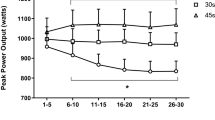Abstract
Thermal stress is known to impair endurance capacity during moderate prolonged exercise. However, there is relatively little available information concerning the effects of thermal stress on the performance of high-intensity short-duration exercise. The present experiment examined human power output during repeated bouts of short-term maximal exercise. On two separate occasions, seven healthy males performed two 30-s bouts of sprint exercise (sprints I and II), with 4 min of passive recovery in between, on a cycle ergometer. The sprints were performed in both a normal environment [18.7 (1.5)°C, 40 (7)% relative humidity (RH; mean SD)] and a hot environment [30.1 (0.5)°C, 55 (9)% RH]. The order of exercise trials was randomised and separated by a minimum of 4 days. Mean power, peak power and decline in power output were calculated from the flywheel velocity after correction for flywheel acceleration. Peak power output was higher when exercise was performed in the heat compared to the normal environment in both sprint I [910 (172) W vs 656 (58) W; P < 0.01] and sprint II [907 (150) vs 646 (37) W; P < 0.05]. Mean power output was higher in the heat compared to the normal environment in both sprint I [634 (91) W vs 510 (59) W; P < 0.05] and sprint II [589 (70) W vs 482 (47) W; P < 0.05]. There was a faster rate of fatigue (P < 0.05) when exercise was performed in the heat compared to the normal environment. Arterialised-venous blood samples were taken for the determination of acid-base status and blood lactate and blood glucose before exercise, 2 min after sprint I, and at several time points after sprint II. Before exercise there was no difference in resting acid-base status or blood metabolites between environmental conditions. There was a decrease in blood pH, plasma bicarbonate and base excess after sprint I and after sprint II. The degree of post-exercise acidosis was similar when exercise was performed in either of the environmental conditions. The metabolic response to exercise was similar between environmental conditions; the concentration of blood lactate increased (P < 0.01) after sprint I and sprint II but there were no differences in lactate concentration when comparing the exercise bouts performed in a normal and a hot environment. These data demonstrate that when brief intense exercise is performed in the heat, peak power output increases by about 25% and mean power output increases by 15%; this was due to achieving a higher pedal cadence in the heat.
Similar content being viewed by others
Author information
Authors and Affiliations
Additional information
Accepted: 1 September 1998
Rights and permissions
About this article
Cite this article
Ball, D., Burrows, C. & Sargeant, A. Human power output during repeated sprint cycle exercise: the influence of thermal stress. Eur J Appl Physiol 79, 360–366 (1999). https://doi.org/10.1007/s004210050521
Issue Date:
DOI: https://doi.org/10.1007/s004210050521




